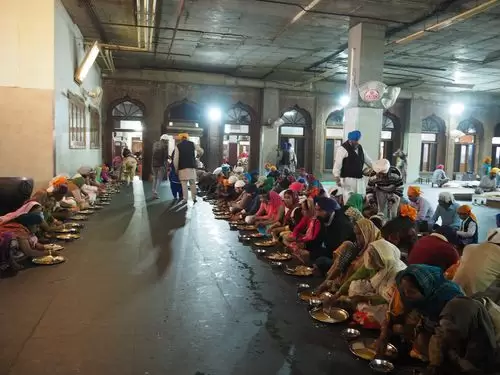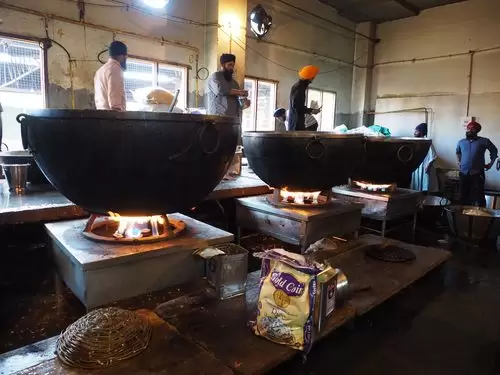Imagine a place where thousands of people, regardless of caste, religion, or social status, gather every day to share a free meal. This place is the Langar Hall of the Golden Temple in Amritsar, India. Located in the state of Punjab, this iconic site embodies the values of the Sikh community: brotherhood, equality, and selfless service.
The Langar Hall, the community dining hall of the Golden Temple, is one of the largest of its kind in the world. Every day, dedicated volunteers prepare and serve free meals to thousands of visitors, whether they are pilgrims, tourists, or locals. This service, known as "Langar," is based on the principles of sharing and equality, fundamental pillars of the Sikh faith.
Upon entering the Langar Hall, one is immediately struck by the hustle and bustle of activities: volunteers chopping vegetables, kneading dough, cooking traditional dishes, and serving with smiles and dedication. The meals are simple but nutritious, often consisting of dal (lentils), roti (flatbread), and vegetables, accompanied by tea.
What particularly sets the Langar Hall apart is its openness to all, without any discrimination. Whether they are wealthy businessmen, foreign tourists, or poor local workers, everyone is treated with the same respect and dignity. This practice embodies the spirit of equality and service that lies at the heart of Sikh philosophy.

Amritsar • Golden Temple's Langar Hall: the plates

Amritsar • Golden Temple's Langar Hall: the dining room

Amritsar • Golden Temple's Langar Hall: the kitchen
The Hidden Stories and Motivations Behind the Creation of the Langar Hall at the Golden Temple
Imagine stepping back into the 16th century, a time when India was deeply divided by caste and religious distinctions. It was in this context that the Langar Hall at the Golden Temple in Amritsar, India, was established, representing a bold vision of fraternity and equality that reflected the core values of the Sikh community.
The Langar Hall, part of the Golden Temple complex, was conceptualized under the leadership of Guru Arjan Dev, the fifth Sikh Guru. While the concept of Langar, or community kitchen, was introduced by Guru Nanak, the founder of Sikhism, it was under Guru Arjan that it took on a monumental scale. The motivation behind this initiative was deeply rooted in the principles of equality, selfless service, and community solidarity, challenging the rigid caste and class norms of the time.
Historical and Global Context
In the late 16th century, the world was undergoing significant transformations. Europe was in the throes of the Renaissance, marked by advancements in arts and sciences, while the Mughal Empire was solidifying its power in India. Amid these global changes, the Sikhs aimed to establish a society based on humanistic and egalitarian principles. The creation of the Langar Hall was part of this vision of an inclusive community where everyone, regardless of their background, could share a meal and feel equal.
Construction and Major Transformations
Although specific statistics regarding the duration, cost, and labor involved in the construction of the Langar Hall are not readily available, it is known that the construction of the Golden Temple and its surrounding structures, including the Langar Hall, involved thousands of workers and took several years. The Sikh community played a crucial role in this endeavor, contributing donations and voluntary labor.
Over the centuries, the Langar Hall has undergone several major transformations. After Ahmad Shah Durrani's attack in 1762, the Temple and Langar Hall were rebuilt by the Sikhs. During the British colonial period, the Langar Hall remained a place of resistance and refuge for Indian independence activists.
Significant Historical Events
One of the most significant events occurred in 1984 during Operation Blue Star, when the Indian Army besieged the Golden Temple to remove Sikh separatists. This operation caused substantial damage to the temple complex, including the Langar Hall. However, the Sikh community once again demonstrated resilience by rebuilding and renovating the damaged structures, reaffirming their commitment to their traditions.
Cultural Importance and Current State
The Langar Hall is not just a place for serving food; it is a powerful symbol of the Sikh spirit of selfless service (seva) and equality (sarbat da bhala). Its capacity to feed over 100,000 people daily, regardless of caste, religion, or social status, makes it a living example of the practical application of Sikh teachings.
Today, the Langar Hall is well-maintained, thanks to the ongoing efforts of the Sikh community and volunteers from around the world. However, it faces specific challenges related to managing the massive influx of visitors and maintaining high standards of cleanliness and hygiene. Modern measures, such as waste management systems and recycling facilities, have been implemented to address these challenges.
Conclusion
The Langar Hall at the Golden Temple stands as a living testament to the cultural and spiritual heritage of the Sikhs. Its creation, driven by principles of fraternity and equality, its history marked by tumultuous events, and its functional architecture make it a monument of global significance. Despite challenges, it continues to serve as a beacon of humanity and altruism, inspiring millions of people worldwide.
The Architectural Innovation of the Langar Hall at the Golden Temple in Amritsar
Walking around the majestic Golden Temple in Amritsar, one's attention is inevitably drawn to the Langar Hall, an impressive structure that epitomizes the innovation and technical mastery of its time. The construction of the Langar Hall is not only a remarkable example of functional architecture but also embodies the Sikh community's values of equality and service.
Historical Context and Construction Techniques
Built in the late 16th century under the supervision of Guru Arjan Dev, the fifth Sikh Guru, the Langar Hall was designed to cater to the needs of a large community. At a time when social distinctions were rigid, the Langar Hall represented a space where all were equal. The architecture of the Langar Hall reflects this philosophy through its open and welcoming design.
The construction techniques used in the Langar Hall's erection demonstrate a high level of engineering prowess for the period. The primary materials used were local bricks and marble, chosen for their durability and availability. Local artisans, supported by Sikh volunteers, worked for several years to complete this monument. While precise statistics on the cost and duration of the construction are not available, the community effort and resources invested were substantial.
Unique Architectural Features
One of the most striking features of the Langar Hall is its immense community kitchen, designed to prepare thousands of meals daily. This kitchen is equipped with large copper cauldrons and industrial-sized hot plates, allowing for rapid and efficient meal preparation. The kitchen layout promotes smooth workflow and strict hygiene, crucial aspects for feeding a large number of people daily.
The main dining hall, where meals are served, is a vast room with high ceilings and large windows, ensuring natural ventilation and abundant light. Diners sit in rows on the floor, symbolizing equality and unity. This arrangement also optimizes space usage and facilitates crowd management.
Architectural Innovations and Global Recognition
The architecture of the Langar Hall incorporates several innovations that were advanced for its time. For example, the use of local materials combined with traditional construction techniques shows a deep understanding of the environment and available resources. Furthermore, the emphasis on hygiene and functionality in the community kitchen's design illustrates a pragmatic and forward-thinking approach.
These architectural features contribute significantly to the Langar Hall's global recognition. Its capacity to feed over 100,000 people daily without discrimination makes it a living example of the practical application of Sikh principles of selfless service and equality. The Langar Hall has become an international symbol of hospitality and community solidarity.
Current State of Conservation and Challenges
Today, the Langar Hall is well-maintained thanks to the ongoing efforts of the Sikh community and volunteers from around the world. However, it faces specific challenges related to managing the massive influx of visitors and maintaining high standards of cleanliness and hygiene. Modern waste management systems and recycling facilities have been implemented to address these needs.
Conclusion
The Langar Hall at the Golden Temple in Amritsar is much more than an architectural structure. It represents a unique fusion of technical innovation and human values. By integrating advanced construction techniques for its time and remaining true to the principles of equality and service, the Langar Hall continues to inspire and serve millions of people worldwide. This monument remains a living testament to the Sikh community's commitment to humanity and altruism.


 English (UK)
English (UK)  Français (France)
Français (France)  Nederlands (nl-NL)
Nederlands (nl-NL)